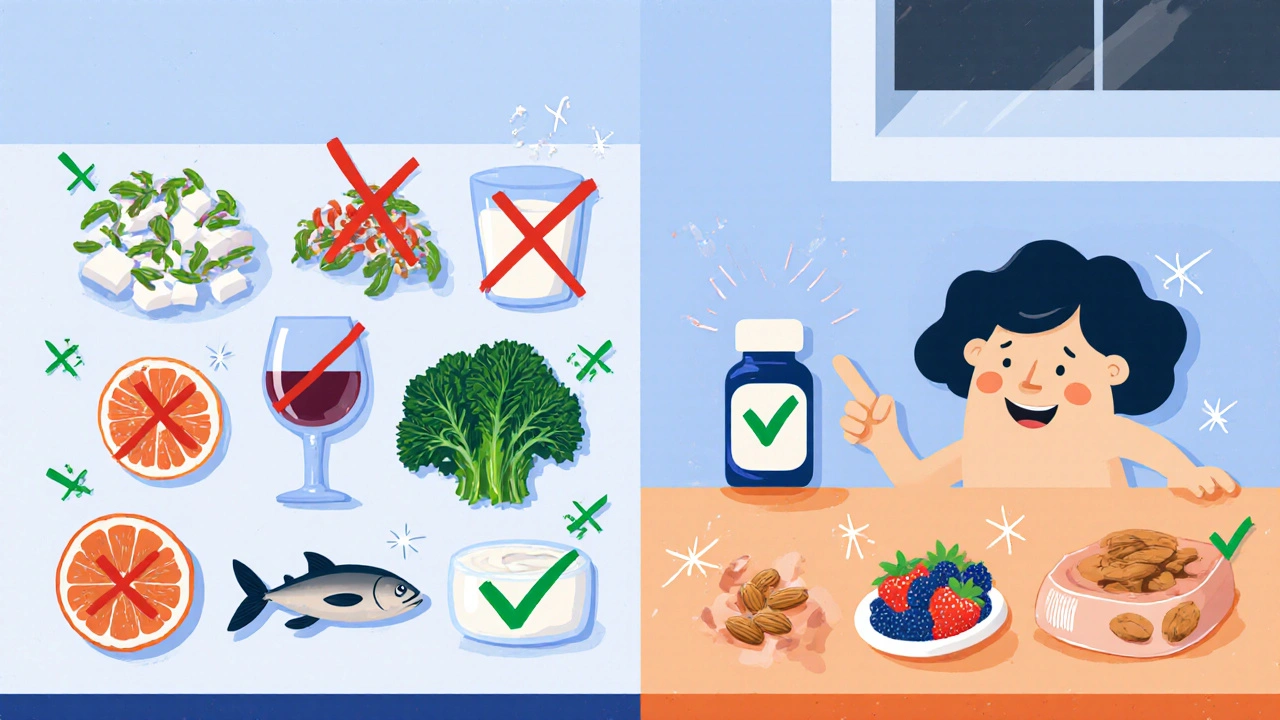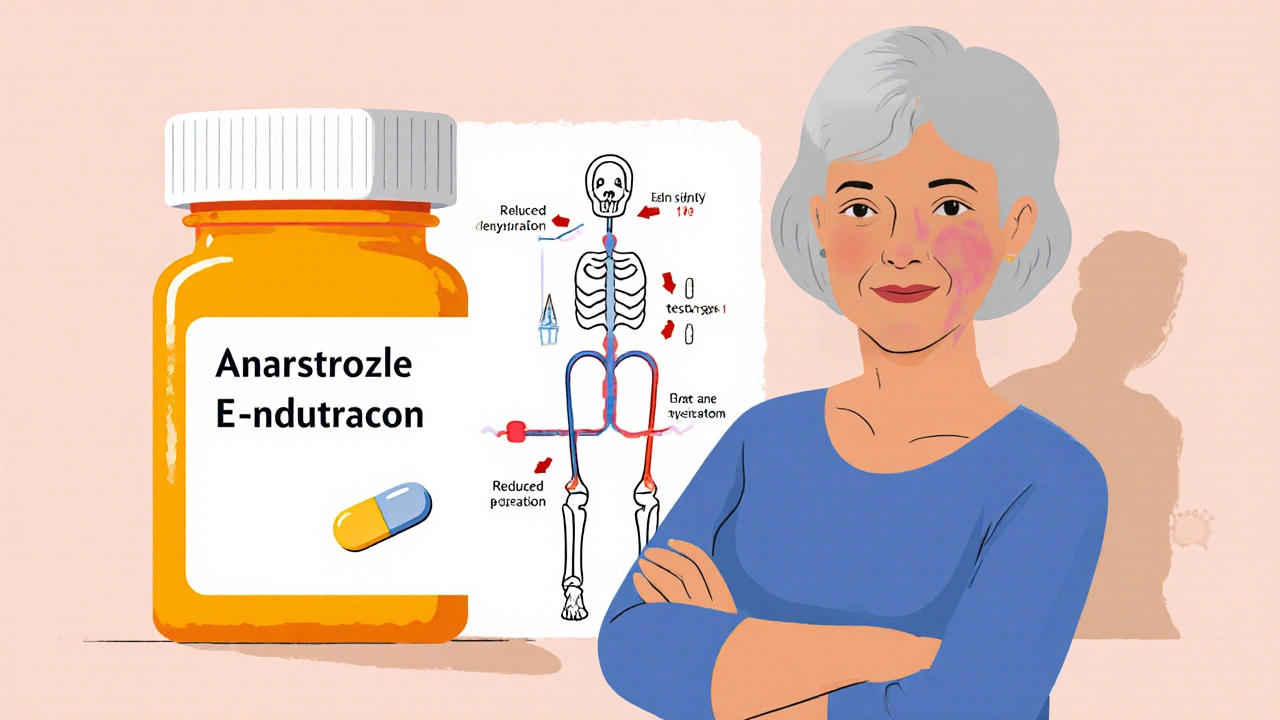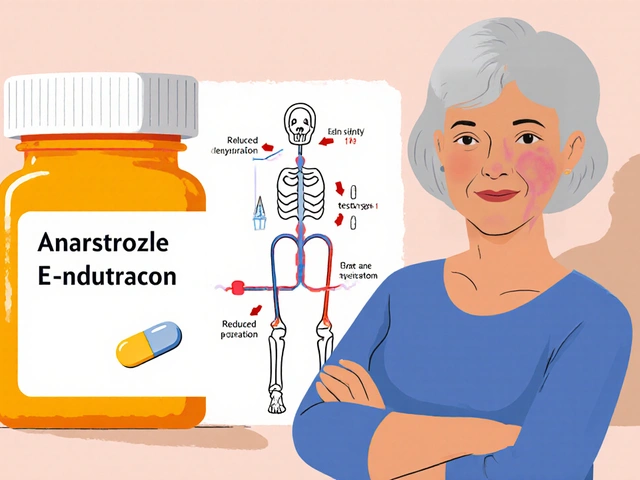Calcium & Vitamin D Tracker for Anastrozole Patients
Anastrozole can reduce bone density. This calculator helps you track your daily calcium (1,200 mg recommended) and vitamin D (800-1,000 IU recommended) intake to support bone health.
Your Results
Your intake needs improvement. Consider adding bone-friendly foods like dairy, leafy greens, and fortified plant milks.
When doctors prescribe Anastrozole an aromatase inhibitor that reduces estrogen production, many patients ask whether what they eat will help or hurt the treatment. The short answer: diet does matter, especially when you’re trying to keep bone health, hormone balance, and overall well‑being in check while on the medication. This guide walks you through the science, the foods to watch, and the supplements that can make a real difference.
Key Takeaways
- Anastrozole blocks the enzyme aromatase, lowering estrogen levels and is often used for estrogen‑positive breast cancer.
- Low‑calcium, low‑vitamin D diets increase the risk of bone loss caused by the drug.
- Foods high in phytoestrogens (soy, flax) may partially counteract anastrozole’s effect, so moderate intake is wise.
- Alcohol and grapefruit can interfere with drug metabolism, potentially raising side‑effect risk.
- Consistent protein, healthy fats, and strength‑training support muscle mass and overall hormone balance.
What Is Anastrozole?
Anastrozole belongs to the class of aromatase inhibitors. It works by blocking the enzyme aromatase, which converts androgens like testosterone into estrogen. Lower estrogen levels are especially useful in treating estrogen‑receptor‑positive breast cancer, but they also affect bone density, lipid profiles, and overall hormone balance.
The typical dose for post‑menopausal women is 1 mg daily, taken orally. Side effects can include joint pain, hot flashes, and most importantly for nutrition, decreased bone mineral density.
How Anastrozole Affects Hormones
By cutting estrogen production, anastrozole indirectly raises circulating testosterone. This shift can feel beneficial for some, but it also means the body relies more heavily on dietary calcium and vitamin D to protect bone health. In addition, the reduced estrogen may alter lipid metabolism, occasionally raising cholesterol levels.
Understanding this hormonal backdrop helps you see why certain foods-especially those that mimic estrogen-might blunt the drug’s intended effect.

Nutrition Basics While on Anastrozole
Nutrition for anastrozole patients revolves around three pillars: bone support, hormone‑friendly macronutrients, and metabolic balance.
- Bone Support: Aim for at least 1,200 mg of calcium and 800-1,000 IU of vitamin D daily. Dairy, fortified plant milks, leafy greens, and safe sun exposure are top sources.
- Protein & Healthy Fats: Adequate protein (0.8-1.0 g per kg body weight) helps preserve lean muscle when estrogen levels dip. Include lean meats, fish, legumes, and occasional nuts.
- Carbohydrate Quality: Choose low‑glycemic carbs (whole grains, berries) to keep insulin steady, which supports hormone balance.
All of these choices work together to counteract the bone‑weakening and metabolic side effects that can accompany anastrozole therapy.
Foods and Substances to Approach With Caution
While no single food will completely negate anastrozole, some have enough phytoestrogen or enzyme‑blocking power to matter.
- Soy isoflavones are plant compounds that act like weak estrogen in the body. Tofu, tempeh, soy milk, and edamame should be limited to a few servings per week.
- Flaxseed, another source of lignans, can also provide estrogen‑like activity. Use it sparingly-one tablespoon daily is a reasonable limit.
- Grapefruit and grapefruit juice inhibit the CYP3A4 enzyme that helps metabolize anastrozole, potentially raising drug levels and side‑effects. Skip them while on therapy.
- Excessive alcohol (more than two drinks per day) can increase estrogen production and impair bone healing, counteracting the drug’s purpose.
- Very high‑fat, processed foods may worsen cholesterol changes linked to reduced estrogen.
Foods That Support Treatment
These foods provide nutrients that help offset the side effects of anastrozole.
| Category | Key Nutrients | Examples |
|---|---|---|
| Calcium‑Rich | Calcium, Vitamin D | Low‑fat milk, fortified soy milk, kale, bok choy, sardines with bones |
| Vitamin D Sources | Vitamin D3 | Fatty fish (salmon, mackerel), egg yolk, UV‑exposed mushrooms |
| Protein Power | High‑quality protein | Chicken breast, turkey, Greek yogurt, lentils, quinoa |
| Healthy Fats | Omega‑3 fatty acids | Walnuts, chia seeds, flaxseed oil (use sparingly), avocado |
| Low‑Phytoestrogen | Minimal estrogenic activity | Broccoli, Brussels sprouts, bell peppers, berries |
Supplement Considerations
Supplements can fill gaps, but they should be used thoughtfully.
- Calcium citrate is well‑absorbed even without stomach acid. Pair with vitamin D for best bone protection.
- Vitamin D3 (cholecalciferol) - 2,000 IU daily is a safe upper range for most adults; blood levels should be checked after three months.
- Magnesium (300 mg) supports calcium metabolism and can ease muscle cramps that sometimes occur with anastrozole.
- Omega‑3 fish oil (1,000 mg EPA+DHA) may improve lipid profiles and reduce joint pain.
- Avoid herbal estrogen mimics such as black cohosh, red clover, and fenugreek unless your doctor explicitly approves.
Always discuss any new supplement with your oncologist or endocrinologist; interactions, although rare, can affect drug clearance.
Lifestyle Tips Beyond the Plate
Nutrition is just one piece of the puzzle. Here are three extra habits that boost anastrozole outcomes.
- Weight‑bearing exercise: Strength training and brisk walking stimulate bone formation and maintain muscle mass, which offsets estrogen loss.
- Monitor BMI: A body‑mass index (BMI) above 30 can increase aromatase activity in adipose tissue, potentially raising estrogen levels despite medication.
- Regular labs: Keep tabs on bone density (DEXA scans), serum calcium, vitamin D, and lipid panels every 6-12 months.
Combining good food choices with these habits creates a supportive environment for the drug’s action.
Frequently Asked Questions
Can I eat soy products while taking anastrozole?
Soy contains isoflavones that act like weak estrogen. A moderate intake-no more than two servings per week-is generally safe, but talk to your doctor if you rely heavily on soy.
Do I need a calcium supplement?
If you can’t meet 1,200 mg of calcium through food alone, a calcium citrate supplement taken with vitamin D is recommended.
Is grapefruit really a problem?
Yes. Grapefruit blocks CYP3A4, the enzyme that metabolizes anastrozole, which can raise drug levels and increase side‑effects. It’s safest to avoid it.
How often should I get my bone density checked?
A DEXA scan every 12‑18 months is typical for patients on long‑term anastrozole, especially if you have risk factors for osteoporosis.
Can alcohol worsen anastrozole side effects?
Excessive drinking can increase estrogen production and impair bone health, so limit alcohol to no more than two drinks per week.
Understanding how anastrozole interacts with your diet puts you in control of treatment success. Pair smart food choices with regular exercise, bone monitoring, and open communication with your care team, and you’ll give your body the best chance to stay strong while the drug does its job.





Comments
First off, the guide tries to act like a one‑stop shop, but it glosses over the biggest red flag – the sheer variability in patient response to anastrozole. The hormone shift is not a linear thing you can fix with a sprinkle of kale, and the article’s tone makes it sound like a diet plan for a fitness influencer. You can’t just swap soy for tofu and expect the drug to keep estrogen at bay, because the isoflavones actually compete with the inhibitor. Moreover, the recommendation of “moderate” soy intake is vague; a balanced reader needs actual gram ranges, not a suggestion that sounds like a casual reminder. You can’t just swap soy for tofu and expect the drug to keep estrogen at bay, because the isoflavones actually compete with the inhibitor. The calcium and vitamin D numbers are spot on, but the guide fails to flag that many patients on aromatase inhibitors also need magnesium and vitamin K2 for proper bone remodeling. Also, the mention of “healthy fats” never explains why omega‑3s matter for lipid profiles altered by low estrogen. The grapefruit warning is accurate, yet the guide doesn’t explain that even a small glass can elevate plasma levels enough to trigger joint pain. The alcohol advice is another weak point – two drinks per week is not “excessive” for everyone, but the article treats it as a universal cutoff without acknowledging individual metabolic differences. The piece also omits the fact that some Asian populations metabolize soy differently due to gut microbiota, which can make the “few servings per week” rule misleading. It skirts around drug–supplement interactions by saying “rare,” but cases of vitamin D toxicity when combined with high‑dose calcium supplements have been reported. The strength‑training recommendation is solid, but the guide should include specific rep ranges for bone‑stimulating loads. The FAQs at the end feel tacked on and repeat information already in the main text, showing a lack of editorial planning. Finally, the guide doesn’t address the psychological impact of lowered estrogen – mood swings, sleep disturbances – which are just as important as the physical side‑effects. In short, the guide is a decent primer but falls short of the depth needed for informed decision‑making.
Wow, that’s a lot to take in, but you’re not alone in navigating these twists and turns. It’s like starring in your own health drama, and the script really does matter. By keeping protein steady, loading up on calcium‑rich greens, and swapping out that grapefruit juice for a splash of orange, you can give anastrozole a solid supporting role. Remember, every bite can either cheer on your cancer‑fighting plan or throw a plot twist you didn’t ask for. So, stay fierce, trust your lab results, and let the nutrition side‑kick do its magic. 💪✨
Oh great, another "miracle diet" for a drug that already messes with your hormones.
Hold up, Ed, it’s not about miracle cures, it’s about solid science wrapped in everyday foods. A balanced plate with calcium‑rich dairy, a splash of vitamin‑D fortified milk, and a bit of oily fish can actually blunt that bone‑loss curve. Skipping the grapefruit isn’t a big sacrifice when you consider the payoff in steady drug levels. And yes, a little strength training every week can keep those joints from squeaking like old floorboards. Bottom line: you don’t need a magic potion, just consistent, smart choices.
Dear reader, while the concerns raised are valid, it is important to note that the recommendations adhere to current clinical guidelines. The calcium and vitamin D targets align with the Institute of Medicine standards, and the caution regarding grapefruit is supported by pharmacokinetic data. Should you require clarification on the specific gram amounts of soy, a consultation with a registered dietitian is advisable. 😊
In the grand theater of oncology, anastrozole is the stern director and nutrition is merely the understudy trying desperately to earn a line. One cannot simply sprinkle kale on a plate and expect the script to rewrite the molecular choreography of aromatase inhibition. The guide, though well‑intentioned, pretends to convey a Gourmet’s banquet when in fact it offers a cafeteria’s leftovers. Real connoisseurs of health understand that the interplay of micronutrients and enzyme pathways demands a masterclass, not a pamphlet. If you aspire to truly support your therapy, you must compose a regimen with the precision of a symphony, not the haste of a pop‑song lyric. Only then will the narrative honor the gravitas of your treatment.
hey i get it you sound fancy but honestly just try to get your calcium in and keep the grapefruit away it works for most people keep it simple and you’ll be fine